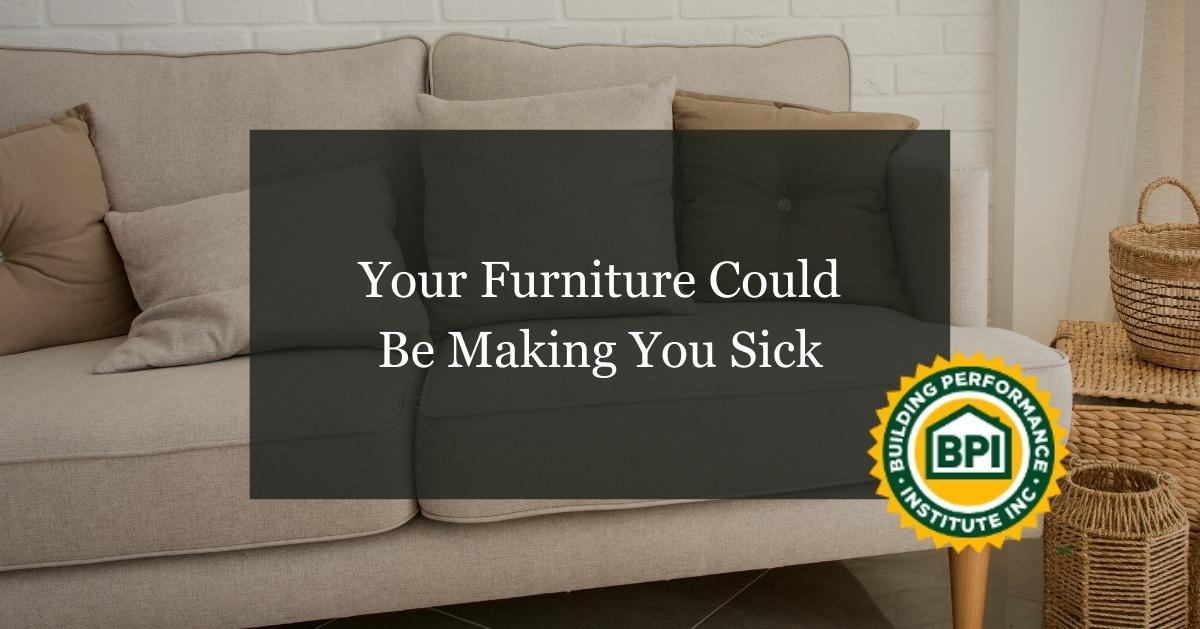Our Blog
How I Learned My Furniture Was Making Me Sick

It was winter in Virginia and I was suffering from regular headaches at home. Whenever I left the house, the headaches would go away. Within half an hour of returning home, my throat would start to become sensitive. Swallowing would begin to feel uncomfortable. The next thing I knew, I'd feel a headache creeping up on me.
It was baffling. And it was happening in the place where I should have felt safest. Instead, I felt dread when it was time to go home.
As a long-time allergy sufferer (some of them anaphylactic), I stay on top of my allergy testing. I take antihistamines and allergy shots. I use saline rinses and nasal sprays.
Mold is one of my primary allergies. So we run dehumidifiers to keep down the possibility of mold growth. Even then, I take petri samples for mold several times a year.
To cut down on dust, we pulled out the carpets years ago. Most of the drapery is long gone. Dust-catching doo-dads are now tucked away on bookshelves with glass sliding doors. And air purifiers run 24/7 in several rooms.
In light of all the precautions we already had in place, my headaches were a real mystery. So, I went into research mode.
Luckily for me, I discovered the concept of IAQ. That's Indoor Air Quality, and it's important. Indoor Air Quality refers to the air quality within and around buildings and structures, especially as it relates to the health and comfort of the people in them. Indoor air quality can be negatively affected by chemicals, pollutants, molds, particulate matter, and more.
Poor indoor air quality can cause irritation of the eyes, nose, and throat, headaches, dizziness, and fatigue, but also aggravation of certain chronic diseases like asthma. Thankfully, many of those common pollutants and other air conditions that affect indoor air quality are measurable using an IAQ monitoring device.
After combing through a lot of ratings and reviews, I settled on the Wave Plus sensor by Airthings.* The Wave Plus casts a large net. It doesn't just measure temperature and humidity. It also measures air pressure, CO2, VOCs (Volatile Organic Compounds) and radon. I had never even heard of some of these things. I certainly wasn't aware I needed to worry about them! I was wrong.
Our VOC levels were high. Airthings defines Volatile Organic Compounds (VOCs) as "a combination of gases and odors emitted from many different toxins and chemicals found in everyday products." We moved the sensor around until we finally found the hot spot: our living room. Around our recliners, the VOC readings were in the red zone!
Before I could go into panic mode, Airthings was sending us notifications. They recommended we open some windows to air the place out immediately, which we did. Then they sent a helpful e-mail, educating us on VOCs and where to start our search for the source. This was much-needed information because not all gases have an odor, which can make them difficult to isolate by smell alone. We were stressed and worried, and I was tired of feeling sick.
But at least we now knew where to start the search. According to the EPA, common VOCs sources include:
- paints
- wood preservatives
- aerosol sprays
- cleaning products and disinfectants
- air fresheners
- hobby supplies
- dry-cleaned clothing
- building materials
- home furnishings
- copiers and printers
- glues and adhesives.
My husband, in his mechanically-inclined way, started turning over furniture, looking for clues. Sure enough, right there on the bottom of our recliners were warning labels: "WARNING: This product contains chemical/s/ known to the State of California to cause cancer, birth defects and/or other reproductive harm."
We moved those recliners out of the house and replaced them with two older recliners we still had on hand. And you know what? The VOCs went down. VOC-wise, our living room now tests as the healthiest room in our home. And my headaches are gone.
Do you notice headaches and other symptoms when you are at home, which fade when you go out? You can get more information on healthy indoor air quality (IAQ) and volatile organic compounds (VOCs), at How to Create a Healthy, Non-Toxic Home.
For further assistance finding someone trained to help you optimize your home's air quality, a BPI Certified Professional can be found here.
*I purchased this device on the open market and didn't receive any compensation or incentive to use or review it. This article represents my own unbiased experience with the product. BPI has not reviewed or endorsed any product in connection with this article.
Categories: General

